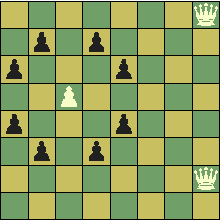
The first player can force a win by placing either the pawn or the queen on one of the four central squares of the board. Here's how it works if the first player chooses the pawn:
First, note that the eight squares that are each a knight's move from the pawn have a special strategic significance. Since each move must bring the queen closer to the pawn, any move from one of these squares will bring the queen to a square from which the pawn can be captured on the next move. Thus both players would like to be able to move the pawn to one of these strategic squares. Yet the second player can't simply place the queen on one of these squares at the beginning of the game, since the rules require that the queen and the pawn must be placed at least three squares apart initially.
As it happens, the first player can always move the queen to at least one of these eight strategic squares, or directly to the pawn, from any other square on the board. This ensures that the first player will win after only one more move.

If the first player places the pawn or queen in any square other than the four in the center, however, the second player will be able to place the other piece in at least one location from which the queen cannot reach any of the strategic squares. The diagram illustrates one such case, with the black pawns marking the eight strategic squares, and the two white queens marking the squares from which neither the target (white) pawn nor any of the strategic squares can be reached. In this case, after the first player moves the queen from either of the positions shown, the second player will be able to move the queen to a strategic square, thereby forcing a win for player 2 in one more turn. Thus the locations marked by the queens in the diagram are also strategic squares, with the difference that these outer strategic squares are more than three squares distant from the pawn, and thus available to the second player for initial placement of the queen.
On a 10x10 or larger board, the second player can always force a win by placing the queen on an outer strategic square. On an infinite board, the strategic squares fall on straight lines. Can you determine the slopes of these lines?